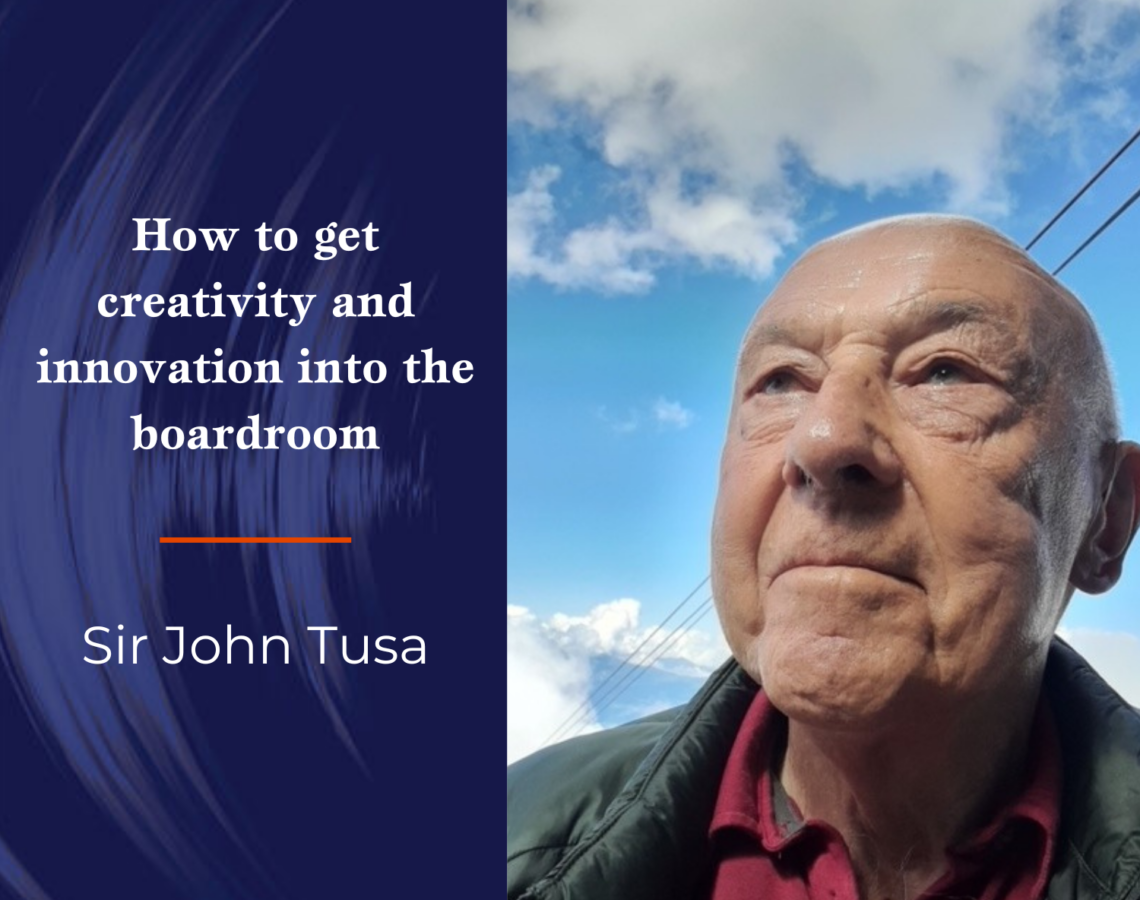How to get creativity and innovation into the boardroom

Many Directors have positive intentions to leverage the experiences gained throughout their careers, support executives, and discuss the big picture in the boardroom. But many become quickly disillusioned, stuck in detail, ticking off boxes and agenda items rather than supporting executives and helping the organisation to make a real mark. So, what can Directors do to spot and support people with big ideas? What does a boardroom look like in an organisation where people can develop ideas, innovate and thrive?
In this podcast, Dr Sabine Dembkowski, Founder and Managing Partner, talks with Sir John Tusa, known to the British public as the main presenter of BBC2’s Newsnight programme. He was Managing Director of some of the most iconic media and cultural centres in the United Kingdom, such as the BBC World Service and the City of London’s Barbican Arts Centre. He chaired the boards of the European Union Youth Orchestra, University of the Arts London and Wigmore Hall. His latest book, “Bright Sparks – How Creativity and Innovation Can Inspire Business Success”, examines 7 case studies of creative innovation against the odds and the board’s role in their success. “Bright Sparks” is short-listed for the Business Book of the Year Award.
“We are here to help to make the organisation a better, more creative place”
Sir John began by observing that a board that is too formal and strictly adheres to rules can stifle creativity. While it is important to follow regulations, boards that only focus on minutes and compliance miss the mark. He advises that boards should focus on fostering innovation, embracing new ideas and striving to make the organisation more dynamic and creative. Unfortunately, many boards seem afraid to take this approach, but he believes it is crucial for organisational growth and board effectiveness. Boards need to support executives in their creative efforts.
“The practice of constant accountability prevents people from having ideas”
Sir John explains that it presents a missed opportunity if a board does not make time for innovation. In effect, the chair and the board run their own business, so they may choose to be bogged down by minutiae. To avoid this, boards should ask if they focus more on responsibility or accountability. He believes accountability often means constantly proving compliance to external parties, while responsibility involves making decisions and owning the outcomes, good or bad. This is how excessive focus on accountability stifles creativity. Boards should, therefore, prioritise responsibility, embrace new ideas, and be willing to accept the consequences of their decisions.
“These people are extraordinary because they have what you might call all the short-term instincts, but also the long-term capacity”
Sir John gives examples from art, culture, and media – remarkable initiatives such as the creation of a Shakespeare Theatre in Gdansk, Poland, and Rory Stewart’s foundation to rebuild Kabul’s historic quarter and revive its arts sector. He also gives another example of a woman who founded the European Union Youth Orchestra despite widespread scepticism. These innovators each had a bold idea and the determination to pursue it. Still, crucially, they also realised they needed boards to sustain their organisations long-term. These boards provided a balance of risk management and support, preserving the original vision and sometimes even defying regulations to ensure success.
He explains that these innovators are exceptional individuals – stubborn and egotistic, yet selfless in their dedication to their organisations. They combine a strong sense of their worth with a selfless commitment to their cause. They also exhibit extraordinary loyalty to their staff, which is then reciprocated. But despite their big visions, such as creating a European Youth Orchestra or restoring old Kabul, they are also incredibly practical. Rory Stewart, for example, personally navigated the rubble of Kabul to drive progress. The European Union Youth Orchestra founder, Joy Briar, meticulously attended to every detail. Their success hinges on a mix of vision, practicality, determination, and patience. Rory Stewart spent six years in Kabul, Yogi Limon took 15 years to build the theatre in Gdansk, and Joy Briar needed about ten years for the orchestra.
“Large organisations have bad habits”
Large organisations often struggle with fostering innovation in Sir John’s experience, and when these organisations aim to be more creative, they typically establish a “creative hub” within the existing structure. However, this approach is almost guaranteed to fail because the hub remains constrained by the organisation’s rules. There is no effective management strategy to “create” innovation within a rigid structure, and simply designating a part of the organisation as the “creative” section is not enough either. It is clear that a new approach is needed to unlock innovative potential and succeed; organisations must embrace the uncertainty and potential chaos that come with genuine creativity and risk-taking. For a large organisation to truly innovate, it must create spaces where normal rules do not apply, allowing ideas to flourish. Sir John accepts that this approach is risky, but it is also necessary for real innovation and a challenge that remains largely unresolved in highly structured institutions. Success within these organisations usually comes from adhering to established norms, not challenging them, whereas true innovation often requires someone to say, “Here’s a new idea; it’s different, but it could be big.” In his opinion, adopting a mindset that values originality and being open to surprises is crucial, and encouraging this attitude can help organisations embrace and nurture external innovations effectively.
“Give yourself permission on a board not to be tied down by rule”
Sir John wishes boardrooms would handle routine business swiftly, perhaps within the first half-hour, and then dedicate the rest/bulk of the time to discussing big ideas. These discussions do not always need conclusions, but they do require an open-minded approach, and the chair and chief executive must foster this creative environment. Board members are not there just for their specific skills; they are there as whole individuals with a range of ideas, and he suggests that many people find board meetings boring because they are not allowed to be creative. Yet every board member is equal and should feel free to contribute unique perspectives. Boards should worry less about strict compliance and more about creating a free atmosphere where ideas can flourish. This approach can redefine the organisation as one driven by ideas rather than just compliance, so boards must permit themselves not to be constrained by rules.
“It’s vital that boards should spend time together”
Sir John explains how essential it is to harness the ideas of the entire board, and a vital aspect of this role is maintaining a close relationship with the Chief Executive. He gives the example of the University of the Arts in London, where he would always communicate his thoughts to the Vice Chancellor first, who did the same. This ensured transparency and trust, and this mutual respect created a strong, effective partnership for seven to eight years. If issues arose, they addressed them directly, maintaining confidence in one another. This openness extended to the board, fostering a culture of fairness and candid communication.
“Why do people behave in such a boring way on boards?”
Spending time together outside formal meetings, as Sir John experienced on an American board, can significantly improve board dynamics because boards need to be enjoyable spaces. So, as chair, focus on creating an open, fun, and collaborative environment while ensuring that the board members feel valued and heard. This will foster an atmosphere where innovative ideas can thrive. He describes how social interaction was valued at the University of the Arts, which helped people know each other as individuals, experts, and people with ideas. He believes that spending time together, both inside and outside the boardroom, is also crucial for building trust. Trust is not built by simply reading minutes, following regulations, and meeting compliance demands because while these are important, they should be taken as a given. But board effectiveness relies on how people interact, so you cannot bring your best to an organisation if you are bored or feel you cannot express your true thoughts. In Sir John’s view, rule one for any board is to be interesting and enjoyable. Without enjoyment and engagement, a board will never foster creativity and innovation. So, prioritise making the board a space where members can connect and share ideas freely. This will lead to a more dynamic, effective, and innovative board.
“You won’t do it just by being stuck in the mud and saying, ‘We’re observing the rules”
Sir John concludes by pointing out that as an individual non-executive director or trustee, you have the power to influence and contribute to creating a vibrant board atmosphere, even if the chair is not taking the lead. He suggests that boards thrive when members feel valued, heard, and motivated to contribute their best. You can help unleash its full potential for creativity, innovation, and impact by advocating for a more open and engaging board environment.
The three top takeaways from our conversation are:
- Remember that a board is there to help create and sustain a vision. The vision comes from the chief executive, but the board can contribute to that and needs to be forward-looking.
- Consider whether everybody contributes equally and is allowed to contribute.
- Be very careful how you deal with objectives. People think something has been done because they’ve achieved the objective, but this might not mean value is added.
Remember to subscribe and never miss an episode of the Better Boards Podcast Series. It’s available on Apple, Spotify, or Google.
To find out how you can participate in the Better Boards Podcast Series or for more information on Better Boards’ solutions, please email us at info@better-boards.com.



